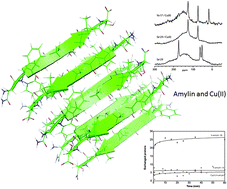The role of copper(ii) in the aggregation of human amylin†
Abstract
Amylin is a 37-residue peptide hormone produced by the islet β-cells of pancreas and the formation of amylin aggregates is strongly associated with β-cell degeneration in type 2 diabetes, as demonstrated by more than 95% of patients exhibiting amylin amyloid upon autopsy. It is widely recognized that metal ions such as copper(II) have been implicated in the aggregation process of amyloidogenic peptides such as Aβ and α-synuclein and there is evidence that amylin self-assembly is also largely affected by copper(II). For this reason, in this work, the role of copper(II) in the aggregation of amylin has been investigated by several different experimental approaches. Mass spectrometric investigations show that copper(II) induces significant changes in the amylin structure, which decrease the protein fibrillogenesis as observed by ThT measurements. Accordingly, solid-state NMR experiments together with computational analysis carried out on a model amylin fragment confirmed the non-fibrillogenic nature of the copper(II) induced aggregated structure. Finally, the presence of copper(II) is also shown to have a major influence on amylin proneness to be degraded by proteases and cytotoxicity studies on different cell cultures are reported.


 Please wait while we load your content...
Please wait while we load your content...